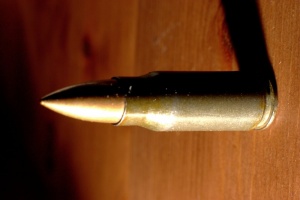7.92x33mm Kurz
| 7.92x33mm Kurz | ||||||||||
|---|---|---|---|---|---|---|---|---|---|---|

| ||||||||||
| German 7.92x33mm Kurz cartridge | ||||||||||
| Type | Rifle | |||||||||
| Country of Origin | Nazi Germany | |||||||||
| Specifications | ||||||||||
| Parent Case | 7.92x57mm Mauser | |||||||||
| Case Type | Rimless, bottleneck | |||||||||
| Bullet Ø | 8.2 mm (0.32 in) | |||||||||
| Neck Ø | 8.9 mm (0.35 in) | |||||||||
| Shoulder Ø | 11.2 mm (0.44 in) | |||||||||
| Base Ø | 11.9 mm (0.47 in) | |||||||||
| Rim Ø | 11.9 mm (0.47 in) | |||||||||
| Case Length | 33 mm (1.3 in) | |||||||||
| Full Length | 49 mm (1.9 in) | |||||||||
| Rifling twist | 1:250 mm (1:10 inch) | |||||||||
| Primer | Berdan | |||||||||
| Production & Service | ||||||||||
| Design Date | 1933[1] | |||||||||
| Used By | Nazi Germany | |||||||||
| Ballistic Performance Sampling | ||||||||||
| ||||||||||
7.92x33mm Kurz is a rifle cartridge developed in Nazi Germany prior to and during World War II. The ammunition is also referred to as 7.92 mm Kurz (Kurz being German for short) and was specifically intended for development of an assault rifle (Sturmgewehr in German). The round was developed as a compromise between the longer 7.92 mm rifle round and the 9 mm pistol round, and is known as an intermediate cartridge.
Contents |
[edit] Background
The 7.92 Kurz was the same caliber as the standard 7.92 mm Mauser German infantry round, which was employed by German infantry in their Mauser 98 rifles, as well as the machine guns employed by infantry units. The German armed forces had issued a 7.92x57mm automatic rifle in limited numbers, the FG42, but the high power of the round meant that automatic fire was difficult to control, with significant muzzle rise. With a case length of only 33 mm, the Kurz round was substantially shorter and delivered less recoil than full-length 7.92 mm rifle ammunition. This meant it could be fired effectively from a weapon that weighed less than a machine gun, yet still had much greater velocity and stopping power than the 9x19mm Parabellum round, which was the standard for German submachine guns.
The shortage of brass in the later stages of World War II led to the use of steel for the new cartridge. The Kurz cartridge incorporated more taper than the parent case; steel is less elastic than brass and more difficult to extract. This led to the distinctive curved magazine for weapons that used this cartridge. The cases were typically lacquer-coated to prevent corrosion.
[edit] Firearms for the 7.92x33mm
Prior to the development of the Kurz round and its associated weapons, two basic small arms existed to equip the regular infantry rifleman. The battle rifle (a bolt-action rifle in most armies of the time) was the standard small arm, usually incorporating good accuracy and stopping power, but with a very limited rate of fire. The submachine gun was a newer piece of equipment, which offered a very high rate of fire, and a compact size, but was of very limited range and stopping power due to the pistol round (usually 9 mm) it fired. While the Kurz round did not match the range and accuracy of a traditional bolt-action rifle, it more than made up for it in the volume of fire available over the ranges most likely to see infantry combat, and had the stopping power to be deadly. As an effective, intermediate-sized cartridge, the Kurz round was a key evolution in the development of the assault rifle class of firearm.Only a few weapons used this round, among them being the Sturmgewehr 44, Sturmgewehr 45 and Volkssturmgewehr 1-5; and a number of German prototype weapons made during the World War II and a small number of prototype weapons made in other countries after the war.
After World War II, the cartridge was tested and used in prototype rifles in Argentina and Belgium, amongst other nations, during the late 1940s and early 1950s. The first FN FAL prototype was designed to fire the 7.92 mm Kurz. After the war the 7.92 Kurz cartridge was manufactured by the GDR, ČSSR and Egypt.
Demand for the ammunition still exists, as the StG 44 is still in use by some within the Lebanese Forces militia,[3] as well as irregular forces in some countries in the Horn of Africa and the Middle East. 7.92 Kurz ammunition is currently manufactured by the Prvi Partizan factory in Užice, Serbia.
[edit] See also
[edit] References
- ↑ Stevens, R. B. (1991). U.S. Rifle M14: from John Garand to the M21. Pg. 102. Toronto, Canada: Collector Grade Publications.
- ↑ Barnes, Frank C. [1965] (1997). in McPherson, M.L.: Cartridges of the World, 8th Edition, DBI Books, 294,311. ISBN 0-87349-178-5.
- ↑ Lebanese Forces web site
